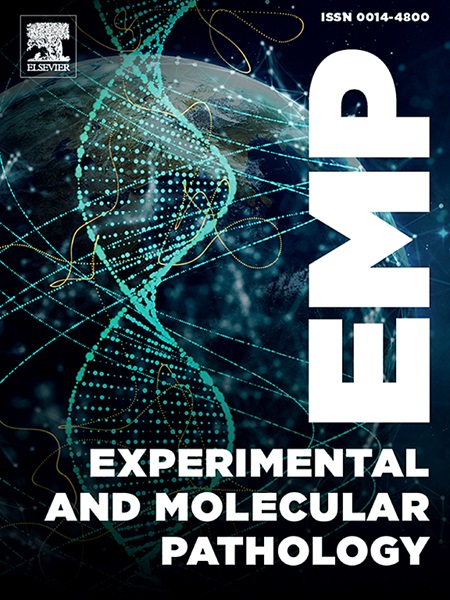Polymerase Ѳ inhibitors combinations with approved and investigational agents in patient-derived tumor multi-cell type (mct) spheroids
IF 3.7
4区 医学
Q2 PATHOLOGY
引用次数: 0
Abstract
The potential of novobiocin, recently identified to be a DNA POLѲ inhibitor, to augment cancer chemotherapy was explored in the late 1980s and early 1990s in tumor cells, tumor-bearing mice and in Phase 1 clinical trial in combination with cyclophosphamide or cisplatin. Genetic alterations which may increase or decrease POLѲ inhibitor effects have been elucidated. Thirty patient-derived tumor cell lines with known BRCA, ATM, ATR, POLѲ, XRCC1, PALB2, PARP1, LIG3 alterations as well as know gLOH% and MSI status were screened in a mct-spheroid assay (tumor cells, endothelial cells, mesenchymal stem cells) with a POLѲ inhibitor, novobiocin, ART-558, and RP6685, alone or in simultaneous combination with a FDA-approved or investigational anticancer small molecule with a 7-day exposure and a CellTiter-Glo 3D luminescence endpoint. As single agents, the POLѲ inhibitors had little or no cytotoxicity. In simultaneous combination with ART-558, talazoparib produced greater-than-additive cytotoxicity at the highest concentrations of the POLѲ inhibitors in the 922,993–354-T-J3-PDC endometrial serous carcinoma mct-spheroids. Activity of the Chk1/2 inhibitor prexasertib was potentiated by either ART-558 or RP6685 in the 922,993–354-T-J3 mct-spheroids. The combination of POLѲ inhibitors ART-558 and RP6685, and the Chk1/2 inhibitor prexasertib produced up to 1 log increase in cytotoxicity in the 922,993–354-T-J3 mct-spheroids. Regions of potentiation were evident in the 922,993–354-T-J3-PDC endometrial carcinoma survival surface plots at the highest concentration of paclitaxel tested, while regions of potentiation were evident in the paclitaxel mid-concentrations of the 299,254–011-R-J1-PDC melanoma mct-spheroids survival surface plots as determined by the Bliss independence calculation. DNA POLѲ is recruited to DNA double-strand breaks as a component of repair. POLѲ allosteric inhibitors, novobiocin, ART558 and RP-6685, have entered clinical trial. The current study explores the cytotoxicity of POLѲ inhibitors in combination with anticancer drugs and investigational agents in patient-derived cell lines grown as mct-spheroids.
聚合酶Ѳ抑制剂与已批准和正在研究的药物联合用于患者源性肿瘤多细胞型(mct)球体
20世纪80年代末和90年代初,在肿瘤细胞、荷瘤小鼠和与环磷酰胺或顺铂联合进行的一期临床试验中,研究人员探索了新生物素作为DNA POLѲ抑制剂的潜力,以增强癌症化疗。可能增加或减少POLѲ抑制剂作用的遗传改变已被阐明。30例已知BRCA、ATM、ATR、POLѲ、XRCC1、PALB2、PARP1、LIG3改变以及已知gLOH%和MSI状态的患者源性肿瘤细胞系,在mct-spheroid试验(肿瘤细胞、内皮细胞、间质干细胞)中使用POLѲ抑制剂、novobiocin、ART-558和RP6685,单独或同时与fda批准的或正在研究的抗癌小分子联合使用,暴露时间为7天,celltir - glo 3D发光终点。作为单一药物,POLѲ抑制剂几乎没有或没有细胞毒性。在与ART-558联合使用时,在最高浓度的POLѲ抑制剂下,talazoparib在922,993-354-T-J3-PDC子宫内膜浆液性癌mct-spheroid中产生了大于添加性的细胞毒性。ART-558或RP6685在922,993-354-T-J3 mct-spheroid中增强了Chk1/2抑制剂prexasertib的活性。POLѲ抑制剂ART-558和RP6685与Chk1/2抑制剂prexasertib联合使用,在922,993-354-T-J3 mct-spheroid中产生高达1 log的细胞毒性增加。在紫杉醇浓度最高的922,993-354-T-J3-PDC子宫内膜癌生存面图中有明显的增强区域,而在紫杉醇浓度中等的299,254-011-R-J1-PDC黑色素瘤mct-spheroids生存面图中有明显的增强区域,这是由Bliss独立计算确定的。DNA POLѲ被招募到DNA双链断裂作为修复的一个组成部分。POLѲ变构抑制剂novobiocin、ART558和RP-6685已进入临床试验。目前的研究探索POLѲ抑制剂与抗癌药物和研究药物联合在mct-球体生长的患者来源细胞系中的细胞毒性。
本文章由计算机程序翻译,如有差异,请以英文原文为准。
求助全文
约1分钟内获得全文
求助全文
来源期刊
CiteScore
8.90
自引率
0.00%
发文量
78
审稿时长
11.5 weeks
期刊介绍:
Under new editorial leadership, Experimental and Molecular Pathology presents original articles on disease processes in relation to structural and biochemical alterations in mammalian tissues and fluids and on the application of newer techniques of molecular biology to problems of pathology in humans and other animals. The journal also publishes selected interpretive synthesis reviews by bench level investigators working at the "cutting edge" of contemporary research in pathology. In addition, special thematic issues present original research reports that unravel some of Nature''s most jealously guarded secrets on the pathologic basis of disease.
Research Areas include: Stem cells; Neoangiogenesis; Molecular diagnostics; Polymerase chain reaction; In situ hybridization; DNA sequencing; Cell receptors; Carcinogenesis; Pathobiology of neoplasia; Complex infectious diseases; Transplantation; Cytokines; Flow cytomeric analysis; Inflammation; Cellular injury; Immunology and hypersensitivity; Athersclerosis.

 求助内容:
求助内容: 应助结果提醒方式:
应助结果提醒方式:


